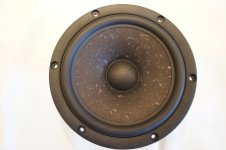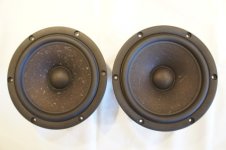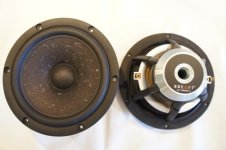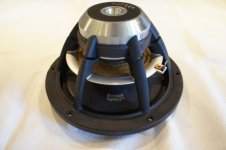Hi,
I bought a pair of these very nice drivers!
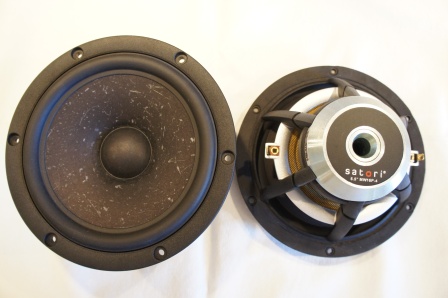
Some initial measurements can be found here:
New Satori MW16P-4 driver units!
The question is what to pair them with?
I have a couple of ScanSpeak drivers I haven't tried yet and I might even do a wave-guide design this time, depending on how my test measurements evolves.
Over & out
/Göran
I bought a pair of these very nice drivers!
Some initial measurements can be found here:
New Satori MW16P-4 driver units!
The question is what to pair them with?
I have a couple of ScanSpeak drivers I haven't tried yet and I might even do a wave-guide design this time, depending on how my test measurements evolves.
Over & out
/Göran
Attachments
These should work very well with a waveguide. What with them having a smooth and extended response and low upper range distortion, could easily cross 2nd order around 2.5kHz for a good directivity match to a similar sized waveguide.
It will be interesting to see your distortion measurements and how well they compare with the other drive units you've already measured. Joachim's first measurements at the lower level showed higher overall 3rd harmonic then when they were driven at a higher level. This I would expect to see if the signal to noise level wasn't optimally arranged for the lower level distortion plots, it could be driver based but I'd be surprised. As you measure at different drive levels it should show exactly what's going on.
It will be interesting to see your distortion measurements and how well they compare with the other drive units you've already measured. Joachim's first measurements at the lower level showed higher overall 3rd harmonic then when they were driven at a higher level. This I would expect to see if the signal to noise level wasn't optimally arranged for the lower level distortion plots, it could be driver based but I'd be surprised. As you measure at different drive levels it should show exactly what's going on.
These should work very well with a waveguide. What with them having a smooth and extended response and low upper range distortion, could easily cross 2nd order around 2.5kHz for a good directivity match to a similar sized waveguide.
Yes, exactly my initial thoughts.
I have to see how the two pair of tweeters I have fit and measures with the wave-guide I have. I also need a new enclosure for the Satoris.
Time will tell!
Regards
/Göran
There is a build with this going on in the vendors threads. I am dying to see how much better they are to the Seas reed cones I just used that I found to be very very good. For three times the price, how much better? Working up a design. SB does have a matching tweeter, but I still have my eye on an air-circ.
I will be interesting to compare our distortion measurements.
I can repeat then my measurements at the level you use with a lab grade condenser mike.
I simply used the Girardin electret capsule that can have some limitations in dynamic range.
I've often wondered about the noise floor of mic's and distortion measurements with drivers.. (..for everything else it seems it's a moot point, but distortion???)
Measurement packages seem to do a compensation thing with a mic sent to L & R, but is there a difference with a better mic and/or mic preamp?
Also which lab mic? ..and what is the noise floor? Is that A-weighted or not?
Thanks.
This one is bigger in size and has less noise.http://www.microtechgefell.de/dmdocuments/MK202_S1+2.pdf
The capsule itself of both mics has even lower noise.
The capsule itself of both mics has even lower noise.
The smaller the size of the capsule, the higher the noise.
Yes. This I know.. BUT does it matter for distortion testing in most instances with available software? (..Arta, Soundeasy, etc..) 130db seems more than sufficient.. no?
Lab-grade electrets:
Here is one with an A-weighted of 18db:
M53 Microphone - Low Noise Electret Condensor Measurement Microphone
For more than double the money you can get to about 13db with an ACO Pacific capsule:
TestMic.com - the best in Precision Mics.
And at around 4 times the price about 10db (SF111a).
Note.. this is compared to the Behringer panasonic capsule types (Dayton EMM-6) which has an A-weighted noise level of 70db (..unmodified panasonic capsule as opposed to SL's lower distortion modification of the same capsule).
Last edited:
I will be interesting to compare our distortion measurements.
I can repeat then my measurements at the level you use with a lab grade condenser mike.
I simply used the Girardin electret capsule that can have some limitations in dynamic range.
I'm using the Earthworks DM30 mic, which is the DEQX branded M30 mic.
Earthworks M30 30kHz Measurement Mic
I think this is a very good microphone and I'm satisfied with it. It might be hard to exactly compare the absolute distortion numbers since we use different equipment and perhaps setup, but we should at least see the same trend and I can compare my measurements with other quality drivers I've measured with the same equipment and setup.
Regards
/Göran
Yes. This I know.. BUT does it matter for distortion testing in most instances with available software? (..Arta, Soundeasy, etc..) 130db seems more than sufficient.. no?
I would say that no, it probably doesn't matter, but you do have to pay attention to the noise floor of the set up and the relative distance the microphone is away from the driver. You can run into problems if you're doing quiet measurements at 1 meter or something as the SnR can get too low once mic + pre amp noise has been accounted for.
Usually I like to set the pre amp gain so that the maximum amplitude measured is just a tad below clipping. If you're measuring quietly, at 1 meter, the noise floor, when done like this, can get very high. Placing the mic closer and reducing the gain increases the SnR and will help if the noise is being an issue, but usually driving summing gets messed up a little when you get too close. If it's a two way then you can easily get the mic into a position where the two drivers sum correctly, even if it requires a bit of experimentation.
I measure distortion in 10cm mostly.
I usually do it between 10-15cm depending on driver size.
Well the reason why measuring quite that close isn't always the best idea is because of the cone geometry and behaviour. At low frequencies measuring up close, where the cone is pistonic, is absolutely fine, but if the driver undergoes controlled breakup and especially if you plan on exploiting this in your design, then the signal coming from the driver wont sum correctly. As far as I've been lead to believe, when the cone goes through breakup, the sound stops emanating from the entire cone area equally and to make sure that you measure this correctly you need to measure in the relative farfield with respect to the cones diameter.
Now how much of a difference this is likely to have is probably minimal, but it's worth bearing in mind if the results have some anomalies in them that you can't explain.
Now how much of a difference this is likely to have is probably minimal, but it's worth bearing in mind if the results have some anomalies in them that you can't explain.
- Status
- This old topic is closed. If you want to reopen this topic, contact a moderator using the "Report Post" button.
- Home
- Loudspeakers
- Multi-Way
- Satori MW16P-4
